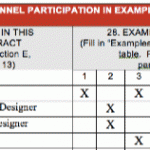One of the major challenges Marketer’s often complain about is working with the technical staff and getting them to see marketing in a better light. I was made aware of this issue when interviewing for my current position. One of the Principal’s first questions to me was, “The marketing and technical groups often have a combative relationship.
How do you plan to deal with this challenge?” My answer was simply that it “doesn’t have to be that way.”
Relationships between the marketing and technical staff can be based on understanding, cooperation, and mutual respect. But before you have the technical staff eating out of your hand, there are a few things you must understand:
- Building relationships with the internal staff is just as important as building relationships with clients.
- Any internal relationship can be built or rebuilt if you know what to do.
- How things “should” work and how things “do” work are often two entirely different things.
- In a business environment, there are only three ways to get people to do what you want.
How a Marketer Can Disappear
Let me give you an extreme example of why its important to forge a great relationship with the technical staff. When I worked for an engineering firm in NJ, I came to know John W., a senior electrical engineer. John was the gruffest and most stubborn engineer I have every had the pleasure to meet. He was a man of few words and if the man smoked one pack a day, he smoked ten.
John was a lot like me in that, in that it took some time for people to “get him.” Some people tended to keep their distance out of fear and misunderstanding. I personally grew to love John and for many years I had a core sample on my desk that was once a staple of John W’s desk. I was lucky enough to see the gentle creamy center beneath his cold rough engineery coating.
But not every marketer made it to John’s good side, which brings me to the main story. One of the firm’s previous marketers, lets call him Steve, would often accompany the engineers to survey sites the team was designing renovations for. And while most of these sites were close, some were a couple hours drive. Unfortunately for Steve, during one wintery trip he got stuck in a car with John W.
It was cold outside, the windows were rolled up, and John W proceeded to fill the car with cigarette smoke. After a couple hours, they reached their destination. Steve got out of the car and said, “John, you are killing me with the smoke. Can you maybe not smoke on the way back?”
John’s response was simply this, “Steve, to me you do not exist.”
From that moment forward, John W lived his life like Steve did not exist. If there was a staff meeting and Steve was talking, John would not acknowledge him. If Steve needed information for a proposal, John would not answer his requests. It became an uncomfortable and unprofessional environment, but it went on until the time Steve left the firm.
Was John a real jerk? Maybe, maybe not.
The Economics of Real World Emotional Banking
Steve made a fatal mistake. He withdrew from an emotional bank account that had no funds. He overdrafted and he paid the penalty. Unfortunately for him, it was a very harsh and terribly unfair penalty.
But the real world is a harsh and a terribly unfair place. In the real world, how things should work and how things do work are two very different things. Very often, we find ourselves focusing on how things should be.
Focusing on how things should be doesn’t get us anywhere. Its much more effective to focus on how things are and what you need to do to get them to where they should be. One way Steve could have done this was through real world emotional banking.
Building Your Nest Egg
Amassing a healthy a healthy nest egg in the emotional bank is quite simple. But like building a building, carvings out a six-pack set of abs, or learning a musical instrument, it takes time and dedication. There is no quick and easy way to build relationships with the staff. Its simply a process of continuously making small deposits into the emotional bank.
Here’s how to start. Write down a list of 15 people in your firm that directly affect your job. More often than not, these are administrators, project managers, principals, and other technical staff. In the sales world, this is called your “hot list.” But we are going to call it your “help list.” Because the best way to build a relationship with someone is to be continuously helpful and caring.
Make the Rounds
One way to make quick deposits into the emotional bank is to “make the rounds.” Many of us are on the road or at our desks most of the time. But when you are in the office, take a few minutes to stand up and walk around to each person on your help list. Ask them about what is going on in their life. Learn about their family, their hobbies, and what they are truly passionate about. Ask questions and listen. Don’t jibber jabber for a half an hour, a couple minutes is fine. Just show them that you care.
Yeah, you are busy. But if you have 15 people to talk to and talk to each for five minutes, its one hour and fifteen minutes a week. If you talk to them for three minutes it totals 45 minutes a week, which is less time than it will take to make up excuses not to do it.
More on this topic next week…





Speak Your Mind